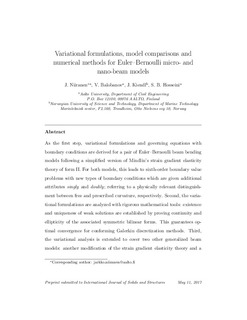| dc.contributor.author | Niiranen, Jarkko | |
| dc.contributor.author | Balobanov, Viacheslav | |
| dc.contributor.author | Kiendl, Josef | |
| dc.contributor.author | Hosseini, S. B. | |
| dc.date.accessioned | 2018-03-15T07:19:39Z | |
| dc.date.available | 2018-03-15T07:19:39Z | |
| dc.date.created | 2017-11-27T16:52:43Z | |
| dc.date.issued | 2017 | |
| dc.identifier.issn | 1081-2865 | |
| dc.identifier.uri | http://hdl.handle.net/11250/2490568 | |
| dc.description.abstract | As a first step, variational formulations and governing equations with boundary conditions are derived for a pair of Euler–Bernoulli beam bending models following a simplified version of Mindlin’s strain gradient elasticity theory of form II. For both models, this leads to sixth-order boundary value problems with new types of boundary conditions that are given additional attributes singly and doubly, referring to a physically relevant distinguishing feature between free and prescribed curvature, respectively. Second, the variational formulations are analyzed with rigorous mathematical tools: the existence and uniqueness of weak solutions are established by proving continuity and ellipticity of the associated symmetric bilinear forms. This guarantees optimal convergence for conforming Galerkin discretization methods. Third, the variational analysis is extended to cover two other generalized beam models: another modification of the strain gradient elasticity theory and a modified version of the couple stress theory. A model comparison reveals essential differences and similarities in the physicality of these four closely related beam models: they demonstrate essentially two different kinds of parameter-dependent stiffening behavior, where one of these kinds (possessed by three models out of four) provides results in a very good agreement with the size effects of experimental tests. Finally, numerical results for isogeometric Galerkin discretizations with B-splines confirm the theoretical stability and convergence results. Influences of the gradient and thickness parameters connected to size effects, boundary layers and dispersion relations are studied thoroughly with a series of benchmark problems for statics and free vibrations. The size-dependency of the effective Young’s modulus is demonstrated for an auxetic cellular metamaterial ruled by bending-dominated deformation of cell struts. | nb_NO |
| dc.language.iso | eng | nb_NO |
| dc.publisher | SAGE Publications | nb_NO |
| dc.title | Variational formulations, model comparisons and numerical methods for Euler–Bernoulli micro- and nano-beam models | nb_NO |
| dc.type | Journal article | nb_NO |
| dc.type | Peer reviewed | nb_NO |
| dc.description.version | acceptedVersion | nb_NO |
| dc.source.journal | Mathematics and mechanics of solids | nb_NO |
| dc.identifier.doi | 10.1177/1081286517739669 | |
| dc.identifier.cristin | 1519107 | |
| dc.description.localcode | © 2017. This is the authors' accepted and refereed manuscript to the article. The final authenticated version is available online at: http://journals.sagepub.com/doi/10.1177/1081286517739669 | nb_NO |
| cristin.unitcode | 194,64,20,0 | |
| cristin.unitname | Institutt for marin teknikk | |
| cristin.ispublished | true | |
| cristin.fulltext | postprint | |
| cristin.qualitycode | 1 | |
